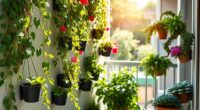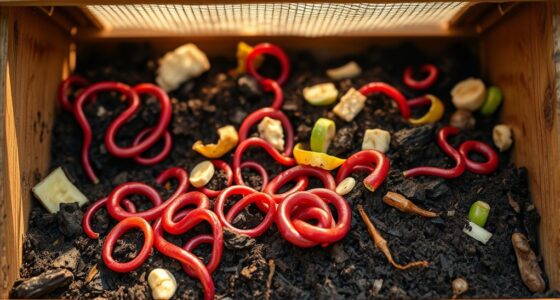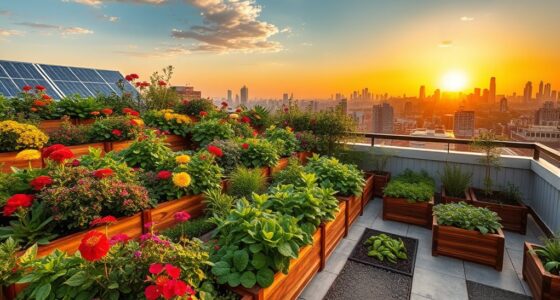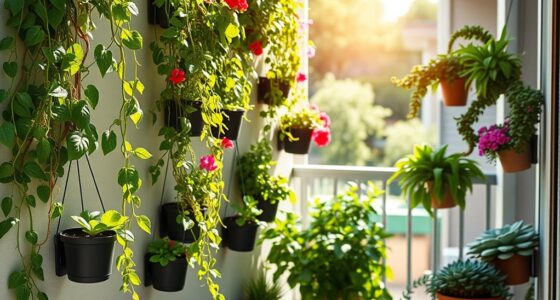To succeed in container gardening, select pots that match your plants’ size, root depth, and style preferences, ensuring they have drainage holes to prevent overwatering. Use appropriate soil, like well-draining potting mix combined with organic matter, to promote healthy roots. Elevate and position containers for stability and ideal sunlight. Properly choosing and caring for your pots and soil helps plants thrive, and exploring further will reveal detailed tips for maintaining a vibrant garden.
Key Takeaways
- Select containers based on plant size, root depth, and desired aesthetic, ensuring they have drainage holes for healthy roots.
- Choose container materials like clay, plastic, or wood based on porosity, weight, and insulation needs.
- Use high-quality, well-draining potting soil tailored to specific plant requirements, adding amendments for improved drainage.
- Elevate containers on stands or risers to improve drainage, stability, and prevent water pooling at the base.
- Adjust container placement seasonally for optimal sunlight, protection from weather, and ease of movement.
Selecting Appropriate Container Sizes and Styles
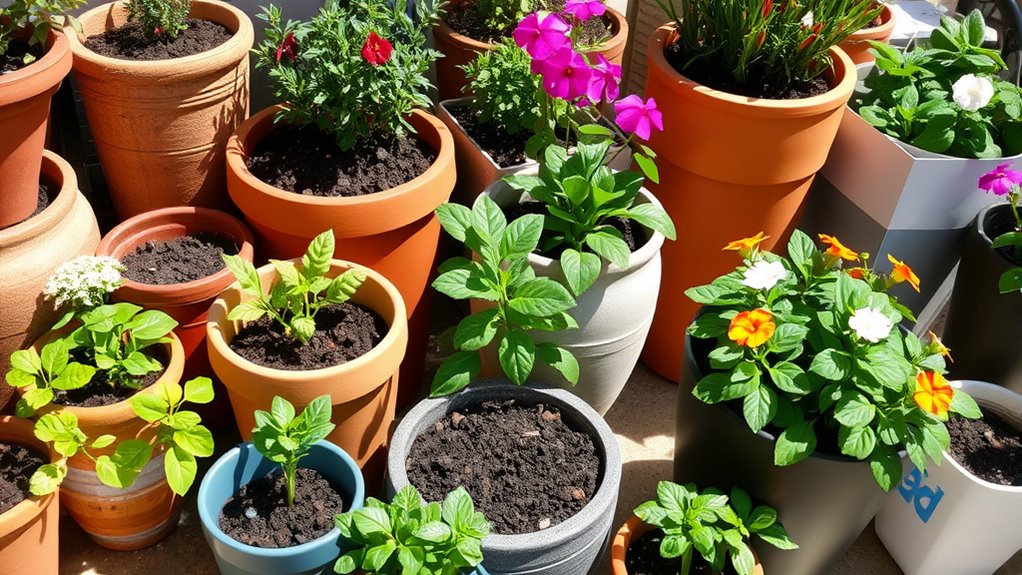
How do you choose the right containers for your garden? Start by considering the size of your plants. Larger containers are ideal for planting multiple or mature plants since they offer more space and last longer. Match the container depth to your plant’s root needs; shallow containers work well for succulents and lettuce, while deeper ones suit vegetables and perennials. Use a variety of pot sizes—large and medium—to add visual interest and dimension. Also, select container styles and colors that complement your home’s exterior or create contrast for visual appeal. Most importantly, guarantee each container has drainage holes to prevent overwatering. Good soil and proper container size are key to healthy, thriving plants in your garden. Incorporating container materials that suit your environment can also enhance durability and aesthetics. Additionally, choosing self watering plant pots can help maintain consistent moisture levels and reduce watering frequency, supporting healthier plant growth. Considering climate adaptability when selecting containers can further ensure your plants thrive in varying weather conditions. Being aware of plant containers and their specific needs will lead to a more successful gardening experience.
Understanding Container Materials and Their Benefits
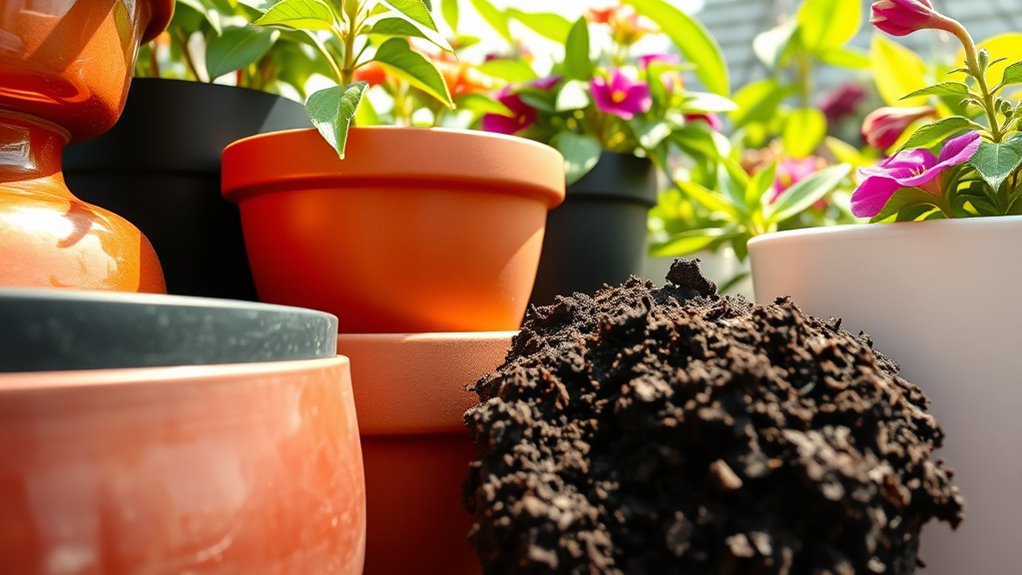
Choosing the right container material can substantially influence your plant’s health and the overall look of your garden. Clay and terracotta pots are porous, allowing air exchange and helping roots breathe. However, they require more frequent watering since soil dries out faster. Plastic and glazed containers are non-porous, retaining moisture longer. This means you can water less often. They’re also lightweight and easy to move around. Cement and metal planters are durable and stable but can heat up quickly, risking root damage if not insulated. Wooden containers offer natural insulation and aesthetic appeal but may rot over time without proper treatment or sealing. Additionally, ensure your containers have drainage holes to prevent waterlogging, and use quality garden soil suited for your plants’ needs. Proper drainage is essential to maintain healthy plants and prevent root rot. Using the right container material tailored to your plant’s requirements can significantly improve growth and longevity. Being aware of the material’s thermal properties can help you choose containers that maintain optimal root temperatures, especially in hot climates.
Ensuring Proper Drainage for Healthy Roots
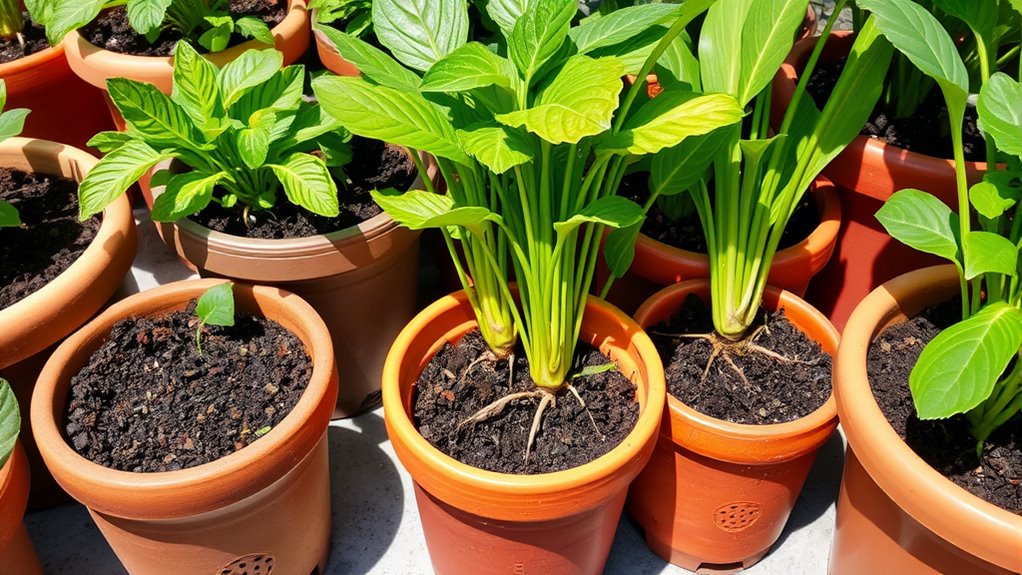
To keep your plants healthy, make sure your containers have drainage holes to prevent water from pooling. If needed, drill extra holes using a household drill and masonry bit for better water escape. Elevating your pots slightly also helps guarantee excess water drains away efficiently. Choosing the right soil type can further improve drainage and promote healthy root growth. Additionally, selecting a well-draining soil mixture can help prevent root rot and maintain optimal moisture levels. Ensuring proper drainage is essential for preventing overwatering and supporting vigorous plant development.
Drill Drainage Holes
Creating drainage holes in your container is essential for healthy plant roots. Proper drainage prevents waterlogged soil, which can lead to root rot and other issues. If your container lacks drainage holes, use a household drill with a masonry bit to carefully create several in the bottom. This allows excess water to escape, keeping soil aerated and moisture levels balanced. Remember not to seal these holes, as blocked drainage can cause standing water and increase disease risk. Regularly check and clear any debris or soil that clogs the holes to ensure adequate water flow. Incorporating proper drainage techniques is vital for maintaining a healthy root environment and preventing plant diseases. Additionally, understanding drainage principles can help you select the best containers and soil mixes for your plants. Creating proper drainage aligns with assessing needs and planning by ensuring your plants have the right environment to thrive. Proper drainage also minimizes the risk of overwatering and encourages healthy root development, leading to stronger, more resilient plants.
Use Appropriate Soil
Using the right soil is essential for ensuring proper drainage and healthy root development in your container garden. High-quality, well-draining potting soil formulated specifically for containers prevents waterlogging and root rot. Avoid garden soil, topsoil, or planting mixes, as they tend to compact and hinder drainage. Incorporate organic matter like compost to boost fertility and moisture retention without causing oversaturation. For succulents and cacti, mix in coarse materials such as pumice or expanded lava to improve drainage. Match the soil volume to your plant’s root depth to avoid over- or under-watering.
| Soil Type | Key Benefit | Suitable For |
|---|---|---|
| Potting soil | Excellent drainage and nutrients | Most container plants |
| Container soil | Tailored for container growth | All potted plants |
| Organic matter | Improves fertility and moisture | Long-term healthy roots |
Elevate Containers Properly
Elevating your containers is a simple step that considerably improves drainage and promotes healthy root growth. By making certain your pots are raised, you prevent water from pooling at the base, reducing the risk of root rot and fungal infections. Proper elevation also helps protect roots from excess moisture and keeps soil moisture levels consistent. Additionally, raising containers off hot surfaces like concrete or pavement minimizes heat stress. Using dollies or wheeled stands makes it easy to reposition your plants for ideal sunlight and seasonal changes. To guarantee stability, make it a point to ensure your containers are securely elevated, preventing tipping caused by wind or uneven surfaces. Maintaining a stable environment supports plant health and overall growth. Incorporating soil drainage techniques is essential for preventing waterlogging and ensuring roots receive adequate oxygen. – Use bricks, wood, or risers for elevation – Keep containers off hot surfaces – Reposition easily with dollies or stands – Prevent tipping with secure placement – Reduce moisture-related issues
Choosing the Right Soil for Container Plants

Choosing the right soil is essential for healthy container plants, and it starts with selecting a high-quality, well-draining potting mix designed specifically for containers. High-quality soil provides the right balance of organic matter and nutrients, supporting vigorous growth and flowering. Using a specialized aroma oil diffuser can also enhance your gardening space by creating a calming atmosphere. Avoid garden soil, topsoil, or planting mixes, as they tend to be too heavy and poorly drained, which can lead to root rot. To improve drainage, mix in amendments like perlite, pumice, or expanded lava, especially for plants with specific needs like succulents. Regularly check your soil’s nutrient levels and replenish them with suitable fertilizers to keep your plants thriving. Proper soil ensures roots get enough oxygen and moisture, creating a healthy environment for your container garden to flourish. Additionally, selecting appropriate soil types based on plant requirements can significantly impact overall plant health and growth, especially considering air purifier features and technology that can help maintain a healthy indoor environment for your plants. Incorporating soil testing can help monitor and optimize soil conditions, ensuring your container plants receive the ideal environment for growth.
Positioning and Stabilizing Your Containers
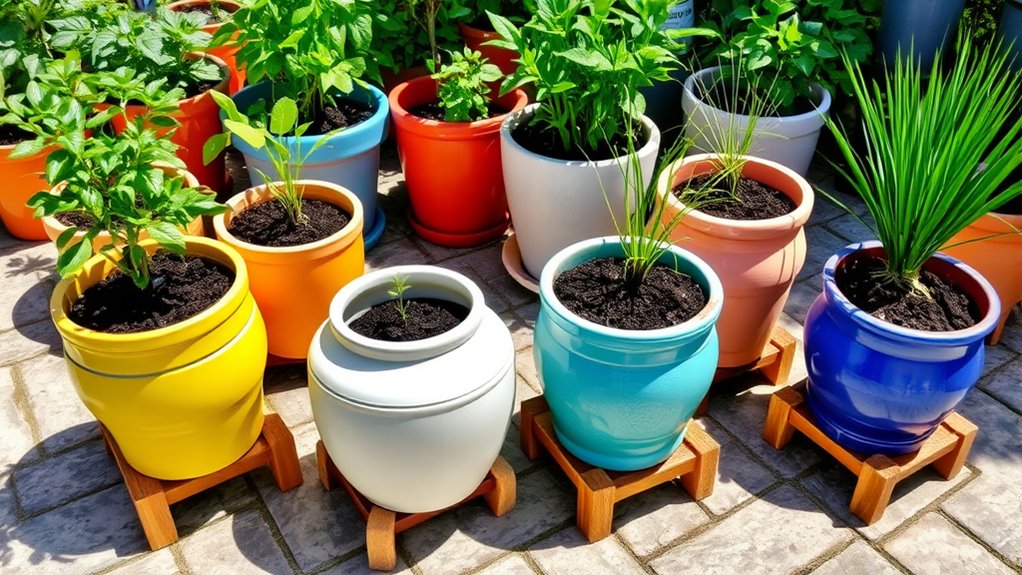
To keep your containers secure and thriving, you need to choose the right spots and stabilize them properly. Place lightweight containers on wheels for easy movement. Elevate them off hot surfaces to protect roots. Remember to adjust their position throughout the year to maximize sunlight and shield plants from harsh weather. Incorporating sustainable materials in your containers can also contribute to environmentally friendly gardening practices.
Optimal Placement Strategies
Proper placement and stabilization are essential for container gardening success. To guarantee your plants thrive, position containers based on their specific sunlight needs—some may require hours of direct sun, while others prefer shade.
Always check the soil before placing your pots; healthy soil promotes strong growth.
Use supports like bricks, wood, or trivets to elevate containers off hot surfaces such as concrete or asphalt, preventing root stress and overheating.
Secure tall or heavy containers with stakes or anchors to stop them from tipping in windy conditions, especially on balconies or rooftops.
Distribute weight evenly across surfaces to avoid structural damage.
Regularly assess your container’s stability and reposition as needed to keep your garden safe and productive.
Securing Containers Properly
Ensuring your containers are secure is essential for a safe and successful garden. Securing containers helps maintain stability, especially on uneven surfaces or in windy conditions.
For tall or top-heavy containers, use brackets, stakes, or weights to prevent tipping. Place your containers on stable, level surfaces, and use shims or leveling tools to ensure proper balance.
For large plants, choose heavy or reinforced containers to add extra stability and reduce the risk of toppling. When moving containers, utilize dollies or wheels to make repositioning easier and avoid damage.
In windy areas, anchor your containers against walls or fences with ties or straps for added security. Proper securing of containers keeps your garden safe and your plants thriving.
Adjusting for Seasonal Changes
Since seasonal changes affect sunlight, temperature, and weather conditions, adjusting your container placement is essential for plant health. To optimize growth and protect your plants, you should:
- adjust container placement to maximize sunlight exposure and shield from harsh weather
- elevate containers off hot surfaces like cement with bricks or trivets to prevent overheating
- use lightweight materials or casters for easy relocation as seasons shift
- secure taller or top-heavy containers with stakes or weights during windy periods
- reconsider positioning in response to seasonal shifts in sun angle and intensity, ensuring plants get the right amount of light and warmth
Regular Maintenance and Soil Care

Maintaining healthy container plants requires regular attention to soil moisture and nutrient levels. You should check soil moisture frequently by inserting your finger about an inch deep; water only when it feels dry to prevent overwatering.
Regular maintenance also means replenishing nutrients weekly with a balanced liquid fertilizer to keep plants vibrant and blooming.
Feed your containers weekly with a balanced liquid fertilizer to promote vibrant, blooming plants.
Additionally, replace or top up the soil annually to refresh nutrients and improve drainage, especially in containers used for multiple seasons.
Remove fallen leaves, debris, or diseased material promptly to reduce pests and disease risks.
Regular pruning and deadheading encourage new growth, maintain plant shape, and prolong flowering.
Frequently Asked Questions
What Is the Rule of Thumb for Container Gardening?
The rule of thumb for container gardening is to select a pot that’s proportional to your plant’s mature size, giving roots enough room to grow without being cramped. Use larger containers for plants with extensive root systems and avoid small pots that restrict growth.
When grouping plants, vary container sizes for visual interest and plant health.
Always guarantee stability and proper drainage to keep your plants thriving.
What Is the Best Soil Mix for Container Gardening?
Did you know that using the right soil mix can boost plant growth by up to 30%?
For container gardening, you should choose a high-quality, well-draining potting mix formulated for containers. Mix in organic matter like compost, and add perlite or pumice for drainage.
Avoid garden soil alone, as it’s too heavy.
Adjust your mix based on your plants’ needs to guarantee healthy, thriving growth.
How Do You Layout a Container Garden?
When laying out your container garden, start by grouping containers in odd numbers like threes or fives for a natural look.
Vary sizes and heights to add depth, placing taller plants at the back or center.
Anchor the arrangement with larger, heavier pots first, then fill in with smaller ones.
Pay attention to sunlight needs and use symmetry or asymmetry to create a balanced, visually appealing display that highlights color and texture.
How Do I Arrange My Garden Pots?
You should arrange your garden pots in a way that creates visual interest and balance. Place taller containers at the back or center, with shorter ones in front for easy viewing.
Mix different sizes, heights, and colors for variety. Make sure to space the pots apart for airflow and maintenance, and consider their sunlight needs to guarantee healthy plant growth.
This thoughtful arrangement will make your garden both attractive and functional.
Conclusion
Your container garden is more than just pots and soil; it’s a reflection of your nurturing spirit. By choosing the right containers, materials, and soil, you’re planting seeds of patience and care that will grow into vibrant life. Remember, each container is a vessel for hope, resilience, and beauty—symbolizing your dedication to cultivating not just plants, but a sanctuary of growth. Tend to it well, and watch your garden flourish as a affirmation to your commitment.

